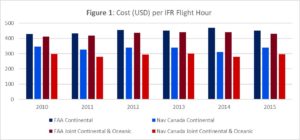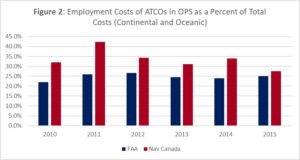Insight
September 12, 2017
Is It Time for the U.S. to Privatize its Air Traffic Control?
Summary
- The Federal Aviation Administration (FAA) has struggled to modernize America’s air traffic control (ATC) system for the past 15 years. The aviation industry’s antiquated, World War II-era technology increasingly drives higher costs and more delays.
- The House Transportation and Infrastructure Committee has proposed transferring air traffic control (ATC) operations from the FAA to a separate not-for-profit corporate entity, similar to the system Canada adopted in 2009.
- Since Canada privatized its ATC system, it has been able to integrate modernized ATC technology, and has seen lower cost per flight hour compared to the United States.
- With an imminent need to modernize America’s ATC system, Congress should look to Canada’s example to achieve a modernized, efficient system for aviation users.
Introduction
With the FAA’s funding authorization set to expire on Sept. 30, Congress must quickly move to pass a reauthorization bill when it returns from recess. A key stumbling block is the debate over ATC reform. The House Transportation and Infrastructure Committee’s FAA reauthorization legislation (H.R. 2997) transfers operations of air traffic services currently provided by the FAA to a separate not-for-profit corporate entity. Opponents of the legislation argue that separating ATC functions from the federal government will negatively impact consumers. However, many other industrialized countries have made the shift and benefited from the change. By reforming their ATC, other countries have created fully self-funding systems with greater flexibility to modernize their technology.
ATC Reform Under H.R. 2997
The House FAA reauthorization bill would transfer FAA’s ATC functions and operations to a new, not-for-profit corporation. The entity would be governed by a 13-member board of directors, representing various aviation stakeholders. Currently, the FAA is funded through aviation-related taxes and general funds, but under the proposed bill, air traffic users would be charged user fees for services rendered. While the new corporation would be responsible for providing ATC services to the public, it would not be responsible for aviation safety. The FAA would remain the regulator of aviation safety and provide safety oversight to the new corporation.
ATC Systems in Other Developed Countries
Many developed countries have transferred air traffic control operations from their government to a separate entity. Australia, Canada, Germany, New Zealand, and the United Kingdom all have self-supporting air traffic control corporations. Additionally, these countries have adopted user fees similar to the fees proposed in H.R. 2997. Table 1 compares the different ATC model in several developed countries.
Table 1: Air Traffic Control Models in Other Industrialized Countries
| Country | ATC Services Operator | ATC Governance | Funding | Safety Regulation Agency |
| Australia | Airservices Australia | Government-owned corporation | User fees | Separate agency |
| Canada | Nav Canada | Private not-for-profit corporation | User fees | Separate agency |
| Germany | Deutsche Flugsicherung GmbH | Government-owned corporation | User fees | Separate agency |
| New Zealand | Airways Corporation of New Zealand. Ltd. | Government-owned corporation | User fees | Separate agency |
| United Kingdom | National Air Traffic Services, Ltd. | Public-private partnership | User fees | Separate agency |
| United States | Federal Aviation Administration | Government agency | Aviation-related excise taxes and general funds | Same agency |
Canada’s model of governance closely resembles the reform outlined in H.R. 2997. Canada’s air traffic control services have been owned and operated by a private, not-for-profit corporation for over 20 years. Nav Canada manages 12 million aircraft movements a year for 40,000 customers, making it the world’s second largest air navigating service provider by traffic volume. Since it privatized its ATC services, Canada has implemented GPS technology, which has helped to lower costs to aviation users. This year Nav Canada announced it would decrease its rates by an average of 3.9 percent from existing base rates, making it the second year in a row that base rates have been reduced. Aviation taxes in the United States have slightly increased in the last two years. Nav Canada is also one of the safest system in the world, and has won three International Air Transport Association Eagle Awards for the best ATC provider.
The Flaws of America’s ATC System
Currently, our system uses World War II-era ground-based radar technology. Ground-based radar requires planes to fly directly over a succession of ground-based radio beacons, forcing planes to fly in zigzag paths. While the rest of the world has moved to a satellite-based system, American air traffic controllers track departing and arriving planes using strips of paper and monitor flight traffic via radar blips . Last year the FAA handled 16 million flights, an overwhelming task given the dated technology. The current technology prevents planes from flying as directly and efficiently as possible, increasing air traffic congestion and travel delays, and costing passenger time and money. Table 1 reports the percentage of total delay minutes that are attributed to national aviation system delays since 2010.
Table 1: National Aviation System Delays, Percent of Total Delay Minutes
| 2010 | 2011 | 2012 | 2013 | 2014 | 2015 | 2016 |
| 25.7% | 24.8% | 22.5% | 24.2% | 23.5% | 22.9% | 23.7% |
Source: Bureau of Transportation Statistics
The current bureaucratic structure of the FAA has experts skeptical that the FAA will be able to handle the necessary ATC technology updates in the future. FAA has struggled for nearly 15 years to roll out the modernized system known as Next Generation Air Transportation (NextGen). NextGen is a system that would equip air traffic controllers with satellite-based GPS tracking technology and digital data sharing, and provide communication infrastructure enhancements, among other modernizations. [1] These technologies would provide passengers with more direct and efficient routes, cutting fuel costs and reducing emissions.
While the vision of NextGen is promising, budget uncertainties and political gridlock have delayed progress toward implementation. Since the ATC is run by the FAA, its funding is subject to the annual appropriations process. This procurement uncertainty resulted in 33,000 air traffic controllers being furloughed in 2013 when the FAA received about $636 million below the amount specified in the FY2013 continuing budget resolution. During the week-long sequester, a total of 7,099 flights were delayed due to the staffing reductions. The Government Accountability Office reported that past budget uncertainty has affected the FAA’s ability to perform its mission and implement NextGen. These delays, combined with the uncertain future of NextGen technologies, have proven costly. Since 2007, the FAA has invested $3 billion in NextGen programs. However, FAA has still not identified the total costs of NextGen, quantified the benefits of the programs, or set schedules for implementing the programs. Costs are estimated to climb to $160 billion by 2030
Benefits of Privatization
Since Canada moved to a privatized ATC system, it has been able to modernize its air traffic technology faster than the United States. Canada began using automatic dependent surveillance-broadcast (ADS-B) – surveillance technology in which an aircraft determines its position via satellite navigation and broadcasts it to be tracked – since 2009. The FAA has begun to slowly integrate ADS-B technology into automation platforms. However, aircrafts will not be required to be equipped with the technology until 2020. Many other components of NextGen are not expected to be functioning until 2025.
The use of satellite navigation is expected to lower aviation costs because aircrafts can fly more direct routes and are able to easily spot and avoid inclement weather, resulting in fewer delays and less fuel use. One would thus expect lower aviation costs in Canada compared to the United States. In fact, data collected from Global Air Navigation Services (ANS) Performance Reports produced by CANSO shows that Canada has consistently lower aviation cost per flight hour than the United States. Figure 1 shows the cost per instrumental flight rules (IFR) flight hours for the United States and Canada. Cost per IFR flight hours measured the cost effectiveness of an air navigation provider, and is commonly used to gauge the performance of air navigation service providers.
Source: CANSO Global ANS Performance Reports (2011 – 2016)
While one might speculate that Canada’s lower average cost per IFR flight hour is a result of lower employment costs, research shows that is not the case. Figure 2 illustrates that employment costs of air traffic control officers (ATCOs) in operations (OPS) account for a higher percent of total costs in Canada than the United States. Since 2010, the U.S.’ employment costs for air traffic control officers as a percent of total costs for continental and oceanic flights have remained consistently lower than Canada’s. Therefore, it is likely that Canada’s on average lower costs per IFR flights are a result of direct flight paths under its modernized technology.
Source: CANSO Global ANS Performance Reports (2011 – 2016)
While there are clear benefits to a modernized ATC system, the FAA has failed to deliver – likely due to both funding and political constraints. For the United States to ahieve lower costs and fewer delays, the ATC system should be reformed. Privatizing ATC would generate reliable funding because revenues would be raised via aviation user fees instead of through the Aviation Trust Fund which requires regular reauthorization. Funding certainty would help to mitigate costly delays in ATC modernization, allowing aviation users to realize the benefits of the new technologies sooner. Furthermore, removing ATC operations from the FAA would free the agency to focus on its primary role as an aviation safety regulatory body, ensuring safety is not compromised when implementing new air traffic technology.
Conclusion
While there is some opposition to reforming America’s ATC system, many countries have implemented similar reforms with great success. Removing air traffic control from governmental constraints has allowed other countries to modernize their technologies at rates faster than the United States, while maintaining a safe system with lower costs. The House Transportation and Infrastructure Committee’s proposal to transfer ATC services to a not-for-profit corporation and reform its funding structure would help to accelerate the modernization of the U.S.’ air traffic technologies and provide the flying public with the most efficient air transportation possible. Privatization would also provide ATC with the flexibility and funding it needs to be an innovator in the air navigation service space.
[1] NextGen includes the following programs: Automatic Dependent Surveillance-Broadcast (ADS-B), System Wide Information Management (SWIM), Data Communications (DataComm), Terminal Flight Data Manager (TFDM), NAS Voice System (NVS), NextGen Weather, and Collaborative Air-Traffic Management Technologies (CATMT)












